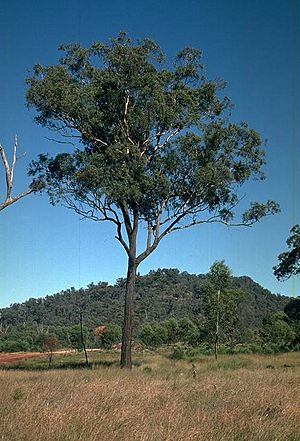Gum-top ironbark facts for kids
Quick facts for kids Gum-top ironbark |
|
|---|---|
 |
|
| Eucalyptus decorticans near Cracow | |
| Scientific classification | |
| Genus: |
Eucalyptus
|
| Species: |
decorticans
|
The Eucalyptus decorticans, often called the gum-top ironbark, is a type of tree found only in Queensland, Australia. This means it is endemic to that area. It has special bark: the trunk and big branches have rough, dark grey or black bark, which is why it's called "ironbark." But its thinner branches have smooth, white bark. This tree also has long, curved leaves, white flowers that grow in groups, and fruit shaped like cones or cups.
Contents
What Does the Gum-Top Ironbark Look Like?
The gum-top ironbark is a tall tree that can grow up to 40 meters (about 130 feet) high. It has a special woody swelling at its base called a lignotuber. This helps the tree regrow if it gets damaged, like from a bushfire.
Its Unique Bark
The bark on the main trunk and larger branches is hard and rough. It's usually dark grey or black, looking like tough "ironbark." But as you look at the smaller, thinner branches, the bark changes. It becomes smooth and can be white, grey, or even yellowish.
Leaves and Flowers
When the tree is young, its leaves are narrow and lance-shaped. They are lighter on the underside. As the tree grows, the adult leaves become lance-shaped to curved. They are the same dull color on both sides and can be up to 12.5 centimeters (about 5 inches) long.
The flowers of the gum-top ironbark are white. They grow in groups of seven. Each flower bud is shaped like a club, spindle, or diamond. You might see these white flowers in April, August, or September.
Fruit of the Tree
After flowering, the tree produces woody fruit. These fruits are like small capsules, about 7 to 9 millimeters long. They can be shaped like a cone, a cup, or a barrel.
How the Gum-Top Ironbark Got Its Name
The gum-top ironbark was first officially described in 1911. A scientist named Frederick Manson Bailey gave it a long scientific name. Later, in 1921, another scientist, Joseph Maiden, changed its name to Eucalyptus decorticans.
The second part of its scientific name, decorticans, comes from a Latin word. It means "without bark" or "peeling bark." This name refers to the smooth, peeling bark found on the tree's smaller branches.
Where Does This Tree Grow?
You can find the gum-top ironbark growing in open forests. It prefers hills and hillsides, especially where the soil is stony clay. This tree is common and widespread across southeastern Queensland, Australia.
Is the Gum-Top Ironbark Protected?
The Queensland Government has a list of plants and animals that need protection. The gum-top ironbark is currently classified as "least concern." This means it is not considered to be at risk of disappearing.

